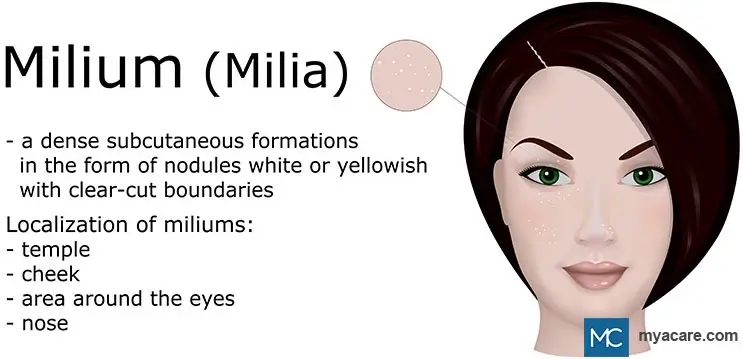Milia Removal- Dermatology
Updated 24th May 2022
Milia are tiny, thump like rankles found under the skin. Basically, they are 1 to 2 millimeters (mm) in size. They appear when skin drops or keratin, a protein, are captured under the skin.
Milia are small white bumps that mostly affect newborn babies. While it is most commonly found on their faces, milia can generally occur anywhere on the body of infants and newborns. Milia are the result of keratin trapping under the surface of the skin. While there is no skin damage as a result of the keratin collection, the white bumps may be a cause of concern aesthetically.

Milia that affects newborns is present from the time of birth and is referred to as primary milia. This type of milia clears up on its own and isn’t the result of any skin damage.
Secondary milia, however, does not resolve on its own and is the result of skin damage such as burns and rashes. Secondary milia require treatment with proper skincare products.
Milia commonly appears on the face, normally around the eyelids and cheeks, but they can be present everywhere. Milia around the eyes can be especially treated with hydrating and nourishing eye creams.
Skincare products can help manage milia if used appropriately. If milia is causing concern, certain treatments may be used to clear them up.
Here are some of the common techniques for removing milia:
De-material
A doctor uses a sterile needle or an instrument with a sharp edge to empty out the milia.
Curettage
- the doctor numbs the area, empties the milia, and then seals the skin with a hot wire.
Cryotherapy
The milia is hardened off with cold from liquid nitrogen.
Topical Retinoids
The vitamin A based skincare treatment helps exfoliate the skin, ridding it of any keratin filled bumps, completely.
Chemical Peels
The way chemical peels work is by removing the top layer of the skin, right underneath which lie the keratin deposits responsible for milia.
When opting for a chemical peel to treat milia, it is important to choose those with salicylic acid or glycolic acid as their main ingredient. However, it is not recommended to undergo a chemical peel for the first time to treat milia as that may cause skin damage.
Minocycline
- antibiotic could help in treating specific types of milia, for instance, milia en plaque.
All these treatments give a risk of scarring, except minocycline, which has other risks. Since milia itself don’t cause scarring, think cautiously before going through these treatments.
Why is milia removal required?
No one exactly knows what makes milia appear or why some people get these lesions more than others. Peer-reviewed studies show that using strong and harsh skin products can cause milia.
Which doctor to consult?
The guaranteed way to treat milia is to see a dermatologist for an extraction.
What to expect during the milia removal procedure?
A sterile needle or an instrument is used first to make a small opening in the lump. Afterwards, the lump can either be removed to decompress with routine cleansing or stripping or be extracted using a comedone extractor. Under trained hands, no damage and no scarring will occur.
Comedone extractors should be disinfected with isopropyl alcohol before use for milia treatment.
Milia occurring under the eyes can be difficult to treat. To remove them, see a dermatologist or an ophthalmologist.
Post-operative care
It isn't entirely possible to avoid the occurrence of milia, as they may often occur in babies neonatally.
Tips for treating milia include:
- Avoiding prolonged exposure to the sun
- Avoiding the use of thick creams or oil-based products
- Exfoliating the skin every two days or more every week
Complications
Milia has very few complications. When milia is triggered by another medical condition, that condition should be managed. If milia is caused by stress, seek therapist help.
References:
- Dermatologist Answers: What Are Milia and How to Get Rid of Them?. (2019). Retrieved from https://www.dermstore.com/blog/what-are-milia/
- Health.com (2019). How to get rid of milia. Retrieved from https://www.health.com/condition/skin-conditions/how-to-get-rid-of-milia
- Hellem, A., & Gary Heiting, O. (2019). How to Get Rid of Milia (Tiny Bumps on Eyelids). Retrieved from https://www.allaboutvision.com/conditions/milia.htm
- Karen Gill, M. (2019). How to get rid of milia: Treatment, prevention, and causes. Retrieved from https://www.medicalnewstoday.com/articles/320953.ph
Disclaimer: Please note that Mya Care does not provide medical advice, diagnosis, or treatment. The information provided is not intended to replace the care or advice of a qualified health care professional. The views expressed are personal views of the author and do not necessarily reflect the opinion of Mya Care. Always consult your doctor for all diagnoses, treatments, and cures for any diseases or conditions, as well as before changing your health care regimen. Do not reproduce, copy, reformat, publish, distribute, upload, post, transmit, transfer in any manner or sell any of the materials on this page without the prior written permission from myacare.com.
